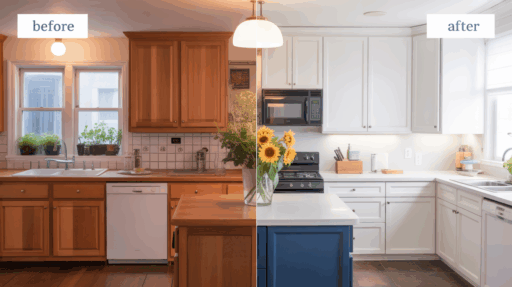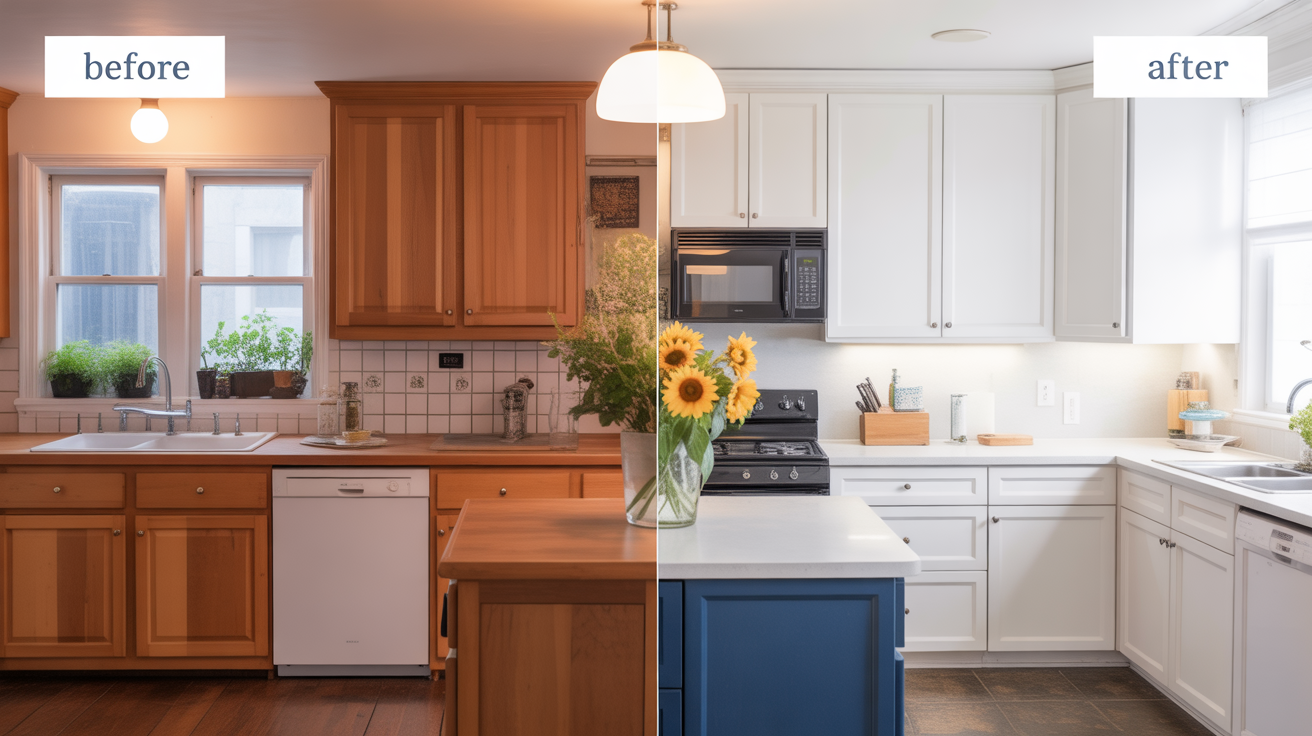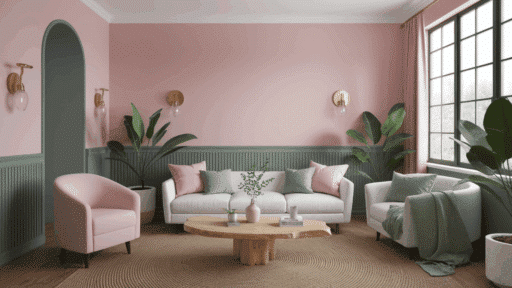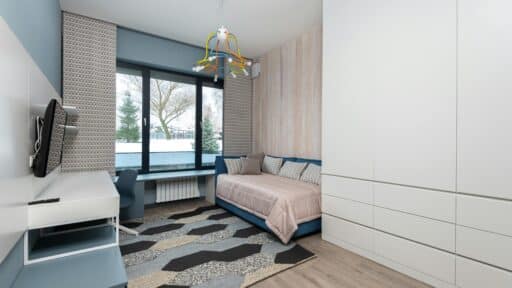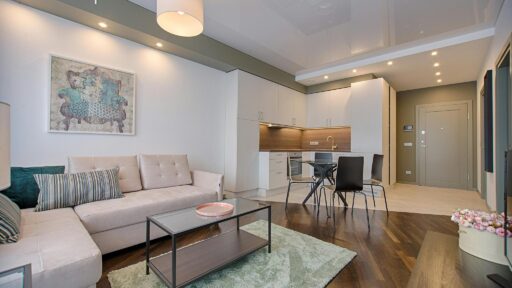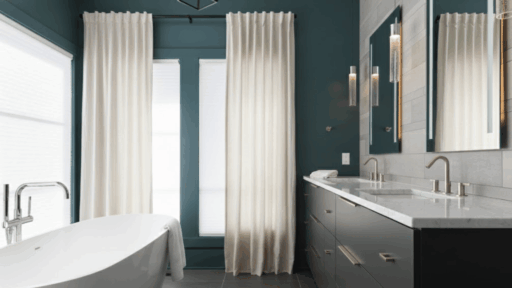Tired of looking at those same old kitchen cabinets every morning? You’re not alone.
Many homeowners stare at their outdated cabinets and dream of a kitchen makeover. But here’s the problem – full cabinet replacement can cost a fortune and turn your kitchen into a construction zone for weeks.
That’s where cabinet refacing comes in. Think of it as giving your cabinets a complete makeover without the headache of starting over.
Plus, you’re being kind to the environment by reusing materials that are still in good shape. This approach gives you a brand-new-looking kitchen without breaking the bank or your daily routine.
What is Cabinet Refacing?
Cabinet refacing involves updating the visible parts of your existing cabinets while keeping the structural framework.
This process includes replacing cabinet doors and drawer fronts, applying new veneer or laminate to the cabinet boxes, and installing new hardware like handles and hinges.
The existing cabinet boxes remain in place, which is why this method is faster and more affordable than full replacement.
Difference Between Refacing and Replacement
The key difference lies in what stays and what goes.
| Refacing | Replacement |
|---|---|
| Keep boxes | Remove all |
| Update exterior | Install new |
| Less expensive | Higher cost |
| Faster | Longer timeline |
Types of Cabinet Refacing
You have several material options for refacing:
- Veneer: Real wood veneer provides a natural wood appearance and can be stained or painted. It’s durable and offers an authentic wood look.
- Laminate: High-pressure laminate comes in many colors and patterns, including wood grain textures. It’s affordable and easy to maintain.
- Solid Wood: For a premium look, solid wood refacing offers the highest quality and durability, though it comes at a higher cost.
The Before: Challenges and Considerations
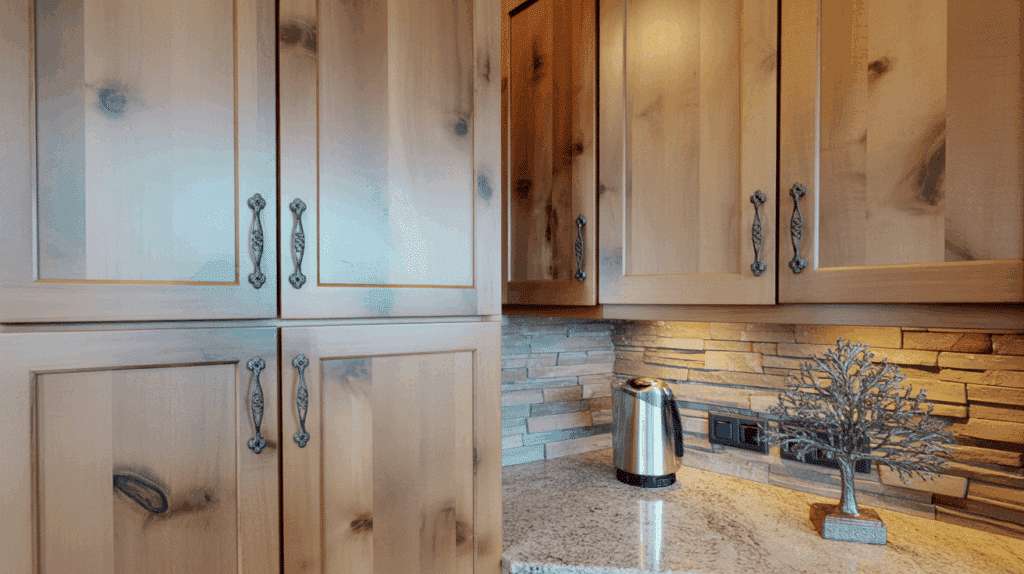
Before jumping into a refacing project, take a good look at what you’re working with. Not every cabinet situation is right for refacing, and knowing the difference can save you time, money, and frustration.
Think of this as your reality check before making any big decisions.
1. Existing Cabinets: What to Expect
Before starting any refacing project, you need to assess whether your current cabinets are good candidates. The cabinet boxes should be structurally sound with no major damage, sagging, or water damage.
Cabinets built using cabinet grade plywood are often the best candidates for refacing since this material offers superior strength, smooth surfaces, and long-term durability compared to particleboard. Its stable construction helps new veneers or laminates adhere evenly, ensuring a lasting finish.
2. Common Issues with Old Cabinets
Many homeowners face similar problems with their existing cabinets:
- Worn or damaged door finishes that look dated
- Outdated hardware that makes the kitchen feel old
- Doors that don’t close properly due to worn hinges
3. When is Refacing the Right Choice?
Refacing makes sense when your cabinet layout suits your needs and the boxes are in good condition. It’s ideal if you want to update the appearance without the expense and disruption of full replacement.
Consider refacing if you’re happy with your current storage configuration, the cabinet boxes are structurally sound, and you want to save money while still achieving a significant visual improvement.
The Refacing Process: What Happens During Refacing?
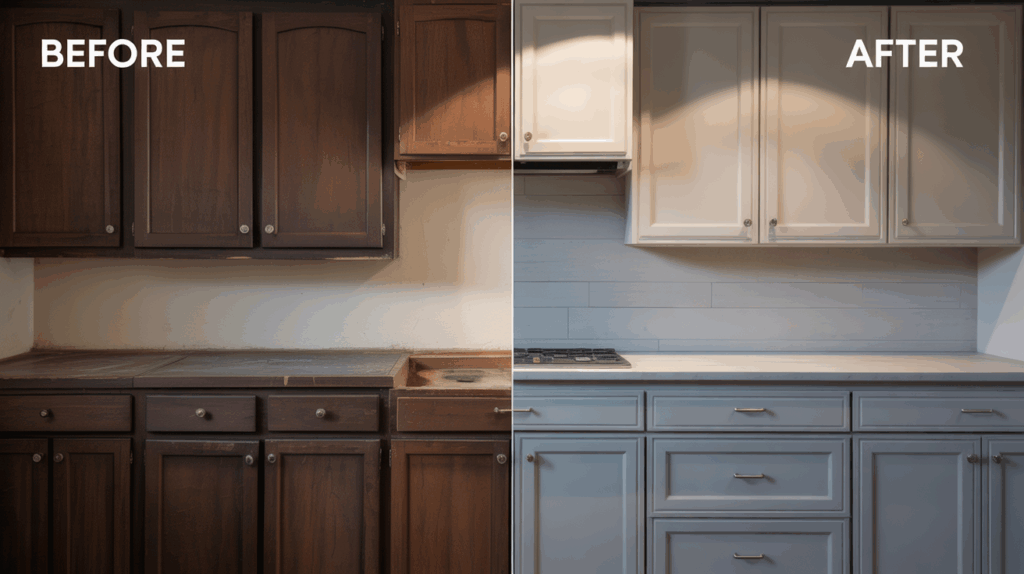
Understanding the refacing process helps you know what to expect and prepare for the project ahead. The good news is that it’s much simpler than complete cabinet replacement and involves fewer steps.
Step-by-Step Overview
Removing Old Doors and Hardware: The first step involves carefully removing all cabinet doors, drawer fronts, and hardware. This includes hinges, handles, and any decorative elements.
Preparing and Cleaning the Existing Cabinet Structures: The cabinet boxes are thoroughly cleaned, and any damage is repaired. Surfaces are sanded smooth to ensure proper adhesion of new materials.
Applying the Veneer or Laminate: New veneer or laminate is carefully applied to all visible surfaces of the cabinet boxes. This requires precision to ensure smooth application without bubbles or wrinkles.
Installing New Doors and Hardware: Finally, new doors and drawer fronts are installed along with updated hardware. This step brings the whole project together and completes the transformation.
Duration of the Project
Most cabinet refacing projects take 3-5 days to complete when done by professionals. DIY projects typically take longer, often 1-2 weeks, depending on your skill level and the availability of time.
The timeline depends on the size of your kitchen and the complexity of the project.
The After: Results of Cabinet Refacing
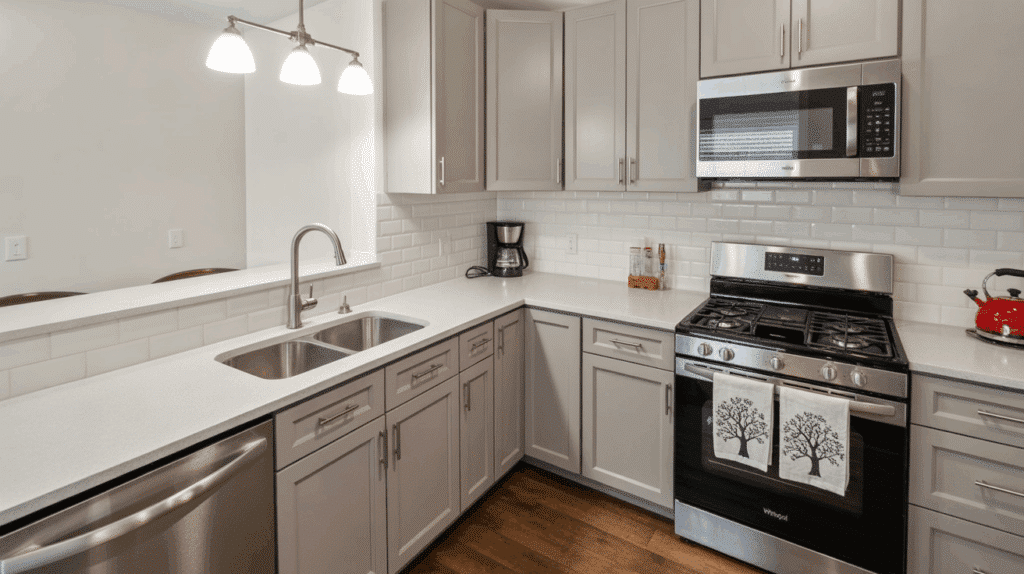
The transformation from old to new cabinets can be truly remarkable. Most homeowners are pleasantly surprised by how much of a difference refacing makes to their entire kitchen’s look and feel.
Designing with Elegance
The visual difference after refacing can be dramatic. Outdated cabinets with worn finishes become fresh and modern.
The new doors and hardware create a cohesive look. Even small details like matching wood grain patterns can make a significant impact on the overall appearance.
Functional Improvements
Beyond its appearance, refacing often enhances cabinet functionality. New hinges ensure doors close properly and stay aligned.
Updated hardware makes doors and drawers easier to open and close. You can also add features like soft-close hinges or upgraded drawer slides during the refacing process.
Real-Life Experiences: Before and After Refacing
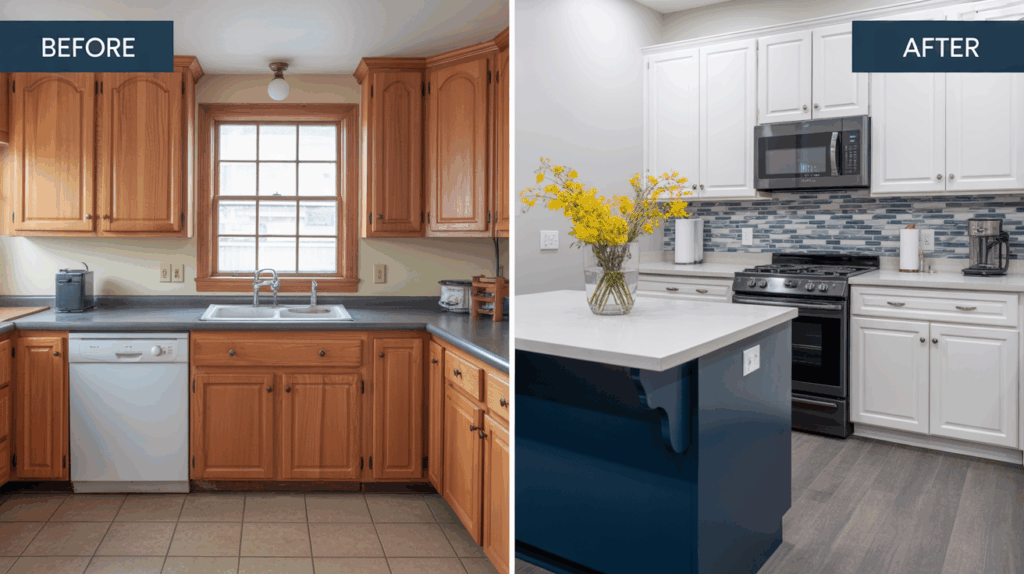
Hearing from people who’ve actually done cabinet refacing gives you the real story behind the process. Their experiences can help you set realistic expectations and learn from their mistakes and successes.
Forum Insights and Reviews
Many homeowners share their refacing experiences online, and the feedback is generally positive. Users frequently mention being surprised by how much the new doors and hardware changed the entire feel of their kitchen.
Common themes in reviews include satisfaction with the cost savings, minimal disruption to daily life, and the professional appearance of the finished product.
Success Stories
Many homeowners report that refacing increased their home’s value and made their kitchen feel completely new. Some mention that guests couldn’t believe the cabinets weren’t replaced entirely.
The combination of updated doors, fresh finishes, and modern hardware creates results that often exceed expectations.
Tips and Best Practices for Cabinet Refacing
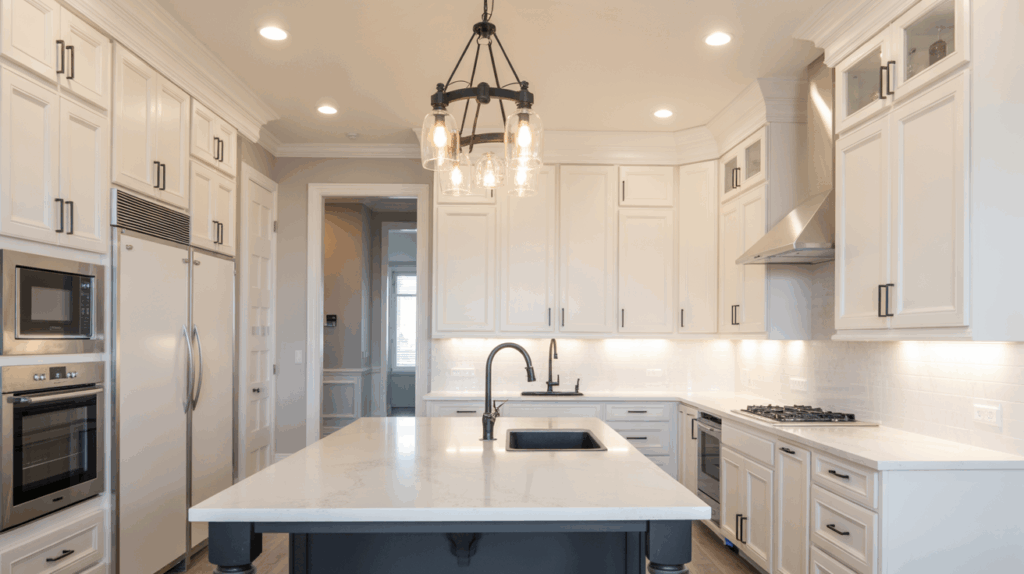
Getting cabinet refacing right the first time saves you headaches and money down the road. These practical tips come from both professionals and homeowners who’ve learned through experience.
Choosing the Right Materials
Consider your lifestyle and maintenance preferences when selecting materials. Laminate is durable and easy to clean, making it good for busy families. Wood veneer offers natural beauty but may require more maintenance.
Match your material choice to your kitchen’s style and your budget. Consider how the new finish will coordinate with your countertops, backsplash, and flooring.
DIY vs. Professional Refacing
Choosing between DIY and professional installation depends on your budget, skills, and timeline. Here’s a quick comparison to help you make a decision.
| DIY | Professional |
|---|---|
| Saves money | Higher cost |
| Requires skill | Expert results |
| Takes longer | Faster completion |
| No warranty | Includes warranty |
Consider your comfort level with home improvement projects and available time. Professional installation might be worth the extra cost for guaranteed results and peace of mind.
Maintaining Your Refaced Cabinets
Proper maintenance extends the life of your refaced cabinets. Clean regularly with products specifically designed for your chosen material.
Address any damage promptly to prevent more significant problems. Use cabinet door bumpers to reduce wear on hinges and prevent cabinet doors from slamming.
Cost Breakdown: What You Can Expect to Pay
Understanding the costs involved helps you budget properly and make informed decisions about your refacing project. Obtaining quotes from multiple sources will provide a realistic picture of what to expect in your area.
| Factor | Description | Average Cost Range |
|---|---|---|
| Size of Kitchen & Number of Cabinets | Larger kitchens with more cabinets tend to increase the cost. | Varies based on size |
| Material Choice | Laminate, wood veneer, or solid wood impact the cost. | Basic laminate: $4,000-$8,000 Wood veneer/solid wood: $8,000-$15,000+ |
| Door Style Complexity | Intricate door styles or custom designs cost more. | Varies based on complexity |
| Hardware Selection | Higher-end hardware (handles, hinges) adds to the total. | Varies based on hardware choice |
| Professional vs. DIY Installation | Professional installation ensures quality, but DIY can save on costs. | Professional: $2,000-$5,000 DIY: Lower cost, but may affect quality |
| Geographic Location | Costs can vary depending on your location, with metropolitan areas often more expensive. | Varies by location |
Pro Tip: To reduce costs, consider laminate over wood veneer or solid wood. Keep existing hardware if it’s in good condition. Do some prep work yourself, shop around for materials, and obtain multiple quotes.
Is Cabinet Refacing Right for You?
Cabinet refacing offers an excellent middle ground between living with outdated cabinets and the expense of full replacement. It works best when your current layout functions well and the cabinet boxes are in good condition.
The process provides significant cost savings, faster completion times, and impressive visual results. However, it’s not suitable for every situation.
If you need to change your kitchen layout, add storage, or your cabinets are in poor condition, full replacement might be the better choice.
If you want a fresh new look without the major expense and disruption of a full renovation, cabinet refacing could be the perfect solution for your kitchen transformation.
Frequently Asked Questions
How Long Does Cabinet Refacing Take?
Professional refacing typically takes 3-5 days, while DIY projects usually take 1-2 weeks, depending on your skill level and the availability of time.
Can All Cabinet Styles Be Refaced?
Most cabinet styles can be refaced, provided the existing boxes are structurally sound. Cabinets with unusual shapes or severe damage may not be good candidates.
Is Cabinet Refacing Worth It?
Refacing is worth it when your cabinet layout works well, the boxes are in good condition, and you want to save money compared to full replacement while still achieving a significant visual improvement.

